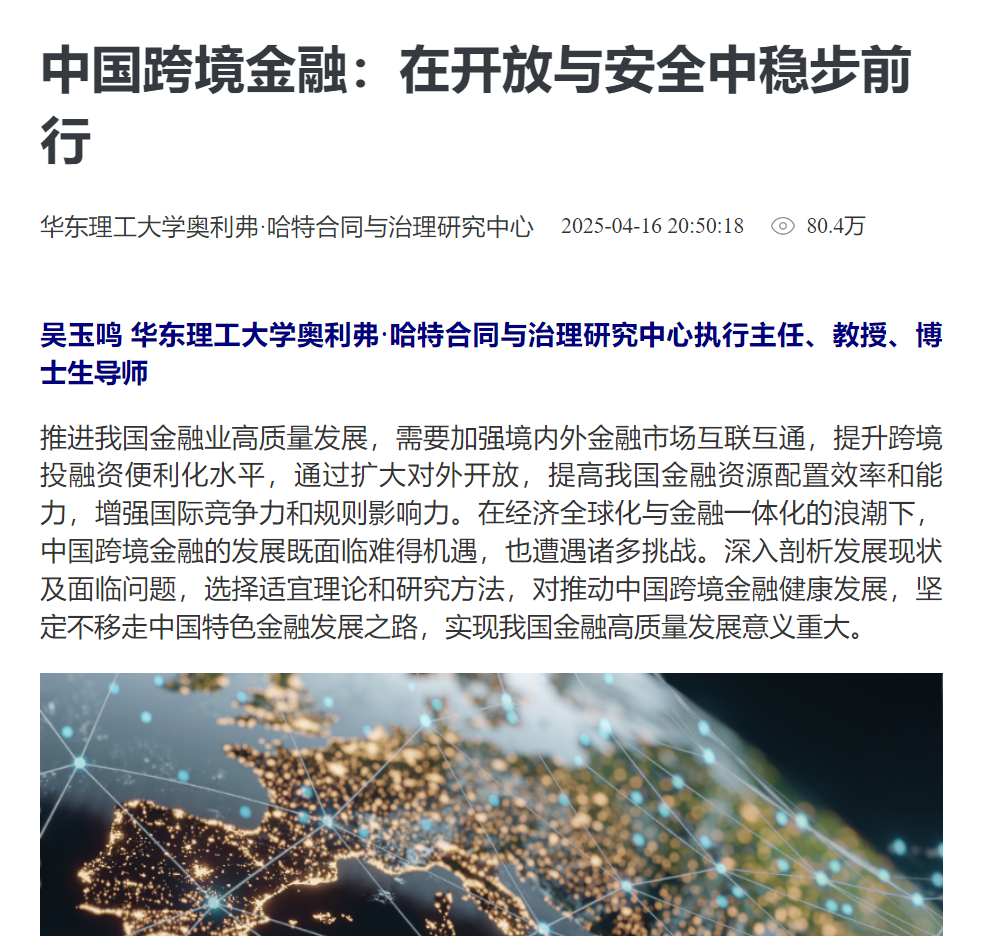Author:哈特中心 Date:2025-04-24

Author: Wu Yuming, Executive Director, Professor and Doctoral Supervisor of Oliver Hart Research Center for Contracts and Governance, East China University of Science and Technology
To promote the high-quality development of China's financial industry, it is necessary to strengthen the connectivity between domestic and foreign financial markets, enhance the facilitation level of cross-border investment and financing, and through expanding opening up, improve the efficiency and ability of China's financial resource allocation, and enhance international competitiveness and the influence of rules. In the wave of economic globalization and financial integration, the development of China's cross-border finance not only faces rare opportunities but also encounters many challenges. It is of great significance to deeply analyze the development status and the problems faced, select appropriate theories and research methods, promote the healthy development of China's cross-border finance, unswervingly follow the path of financial development with Chinese characteristics, and achieve the high-quality development of China's finance.

I. Vigorous Development with Remarkable Achievements
In recent years, the scale of China's cross-border financial market has continued to expand, occupying an increasingly important position in the global financial landscape. In the field of the foreign exchange market, the internationalization process of the RMB has accelerated, and its application in international payment, settlement, and reserve has become more and more extensive. The activity of foreign exchange transactions has significantly increased, and the Cross-border Interbank Payment System (CIPS) has been continuously improved, providing a solid guarantee for the efficient implementation of cross-border RMB business. In 2024, the cross-border RMB settlement volume in Shanghai achieved a historic rapid growth, with the total amount of receipts and payments reaching 29.8 trillion yuan, accounting for 47% of the national business volume. In the field of cross-border investment and financing, Chinese enterprises have steadily stepped out, and the scale of outward direct investment has grown steadily; at the same time, the attractiveness of the Chinese market to foreign capital has been increasing, and the demand for cross-border financing has remained strong. The infrastructure of financial markets such as bonds and stocks has been gradually improved, and the degree of internationalization has been continuously enhanced, creating more convenient conditions for cross-border financial transactions. In 2024, the cross-border RMB settlement amount under the current account was 16.27 trillion yuan, of which the amounts for goods trade, service trade, and other current items were 12.39 trillion yuan and 3.88 trillion yuan respectively; the cross-border RMB settlement amount for direct investment was 8.25 trillion yuan, of which the outward direct investment and foreign direct investment were 3.01 trillion yuan and 5.24 trillion yuan respectively.
There have been fruitful innovations in cross-border financial products and services. In the field of cross-border payment, third-party payment institutions have risen rapidly, breaking the limitations of traditional methods such as bank telegraphic transfer and letter of credit, and providing efficient and convenient payment solutions for industries such as cross-border e-commerce. The pilot of the digital RMB in the field of cross-border payment has opened a new chapter in the transformation of cross-border payment. In terms of cross-border financing, innovative products such as cross-border supply chain finance and cross-border financing with intellectual property pledge have emerged continuously, meeting the diversified financing needs of enterprises. Investment products have also become increasingly rich. Investment channels such as QDII, QFII, RQFII, the Shanghai-Hong Kong Stock Connect, the Shenzhen-Hong Kong Stock Connect, the Bond Connect, and the Swap Connect provide more diversified choices for domestic and foreign investors.
The construction of cross-border financial infrastructure has achieved remarkable results, and a relatively complete system has been established. As the core cross-border payment infrastructure, CIPS is efficient and safe in service, and its coverage and the number of participants have been continuously increasing. By the end of December 2024, CIPS had cumulatively processed various payment businesses with an amount of about 600 trillion yuan. In 2024, CIPS cumulatively processed cross-border RMB payment business with an amount of 175 trillion yuan, a year-on-year increase of 43%. At the same time, China has established mechanisms for the connectivity of financial infrastructure with multiple countries and regions, such as the Bond Connect and the Stock Connect, achieving in-depth docking of domestic and foreign financial markets. The construction of infrastructure such as cross-border credit investigation and cross-border guarantee has also been steadily promoted, laying a solid foundation for cross-border financial business. The policy and regulatory environment has been continuously optimized. The government has gradually relaxed foreign exchange management policies, simplified cross-border investment and financing procedures, established a regulatory system of "macro-prudential + micro-level supervision", strengthened international regulatory cooperation, and effectively prevented cross-border financial risks.
II. Hidden Risks and Numerous Challenges
The international financial market fluctuates frequently. Factors such as the global economic situation, the adjustment of monetary policies in major economies, and geopolitical conflicts can all trigger market turmoil. When major economies raise interest rates and funds flow back, it may lead to the outflow of cross-border capital in China, impacting the stability of the RMB exchange rate and the financial market. The fluctuations in international commodity prices will also affect the cross-border trade and investment returns of Chinese enterprises, and the risk contagion effect is likely to affect China's cross-border financial market.
Cross-border financial business faces complex risks such as exchange rate, interest rate, credit, and market risks. Chinese financial institutions have shortcomings in risk management. Their capabilities in risk identification and assessment need to be improved, the risk hedging tools are limited, and the risk early warning and management system is still not perfect. Especially in the cross-border business of enterprises, the awareness of risk management is weak, and the strategies and means are lacking, making them vulnerable to risk impacts.
There are also adaptability problems in financial regulatory policies. Business innovation is changing rapidly. Some regulatory policies are difficult to keep up in a timely manner, resulting in regulatory lags, blank areas, or loopholes; while some policies are too strict, suppressing the vitality of business development. Cross-border financial supervision involves multiple departments and regulatory authorities in different countries, and it is difficult to coordinate governance, prone to overlaps or conflicts, and reducing regulatory efficiency. In international competition, China's cross-border financial products and services face the dual pressure from international financial institutions and emerging fintech companies. International large-scale financial institutions occupy an advantage with their rich experience, advanced technology, and extensive international network, while emerging fintech companies rise rapidly relying on their technological advantages. Chinese financial institutions have gaps in business expansion, product innovation, and service quality, and their competitiveness urgently needs to be improved.
� �
�
III. Theory as the Foundation, Methods as the Wings
International financial theory is an important theoretical basis for the study of cross-border finance, including theories such as the balance of payments theory, the exchange rate determination theory, and the theory of international capital flow. The balance of payments theory mainly studies the balance and adjustment of a country's balance of payments and analyzes the impact of cross-border trade, investment, and other activities on the balance of payments; the exchange rate determination theory explores the formation mechanism and fluctuation reasons of exchange rates, which is of great significance for understanding exchange rate risks in cross-border finance; the theory of international capital flow studies the reasons, influencing factors, and economic effects of capital flow between countries, providing theoretical support for the analysis of cross-border investment and financing activities.
The risk management theory is an important theoretical basis for dealing with cross-border financial risks, including aspects such as risk identification, risk assessment, risk control, and risk response. In cross-border finance, the application of risk management theory can help financial institutions and enterprises identify and assess various risks, formulate reasonable risk control strategies, and take effective risk response measures to reduce risk losses. For example, use risk assessment models to quantitatively assess risks such as exchange rate risks and credit risks, and then use financial derivatives and other tools for risk hedging.
When studying cross-border financial behavior, attach importance to the literature research method. By consulting relevant domestic and foreign literature, understand the research status and trends, and sort out theoretical achievements; use the data analysis method to collect and analyze market data to reveal the development characteristics and laws; adopt the case analysis method, select typical cases, and summarize experiences and lessons; based on the comparative research method, compare with cross-border financial developed countries and regions, draw on advanced experiences, and propose development strategies suitable for China's national conditions and with Chinese characteristics.
IV. The Road to Breaking the Deadlock, Policies Come First
Against the backdrop of increasingly fierce cross-border financial competition among countries, China should actively participate in the formulation of international financial rules, enhance its voice in the international financial field, and promote the establishment of a fair and reasonable international financial order. On the one hand, strengthen financial regulatory cooperation with other countries, establish a normalized coordination mechanism, share information, and conduct coordinated supervision to avoid regulatory arbitrage. At the same time, actively deepen financial cooperation under the Belt and Road Initiative, and promote the connectivity of financial infrastructure and the facilitation of trade and investment.
Financial institutions should increase investment in technology, use financial technology to optimize business processes, and improve the customer experience. Strengthen the cultivation of cross-border financial talents and cultivate compound professional talents. Promote the standardization construction of cross-border financial services, establish unified standards and specifications, and promote fair market competition. At the same time, state-owned and various commercial financial institutions should strengthen their risk management capabilities, improve risk identification, assessment, monitoring, and control mechanisms, and enhance early warning capabilities. Enrich risk hedging tools, develop financial derivatives suitable for cross-border business, and assist enterprises and financial institutions in managing risks. Strengthen the guidance and training of enterprises' cross-border risk management to enhance their risk awareness and response capabilities.
Regulatory authorities such as the People's Bank of China, the National Financial Regulatory Administration, the China Securities Regulatory Commission, the State Administration of Foreign Exchange, and local financial regulatory bureaus should study and construct a regulatory policy system that dynamically adjusts and organically combines macro-prudential management with micro-level behavior. Keep up with the development trends of various cross-border financial businesses and improve policies in a timely manner to ensure the effectiveness of supervision. On the one hand, balance the relationship between supervision and innovation, encourage innovation in cross-border financial business, and stimulate market vitality. On the other hand, strengthen the coordination and cooperation among regulatory departments, establish a unified and efficient regulatory coordination mechanism, and improve regulatory efficiency.
V. Promising Future, Steady and Far-reaching Development
China's cross-border finance faces both opportunities and challenges in its development. Strengthen the research that combines cross-border financial theory and practice. Through optimization paths such as international cooperation, improvement of risk management, optimization of regulatory policies, and enhancement of service quality, study and propose strategic, operational, and forward-looking strategic measures, which are expected to break through the difficulties and achieve healthy, stable, and sustainable development. In the future, with the continuous growth of the Chinese economy and the further improvement of the openness of the financial market, cross-border finance will play a more important role in the process of economic globalization and the internationalization of the RMB, contribute more Chinese wisdom and strength to global financial development, and achieve high-quality development while balancing openness and security, steadily moving towards new heights.
This article is from Xinhuanet.
http://bj.news.cn/20250416/b061ffe8880c45d2844352095ba2be1a/c.html